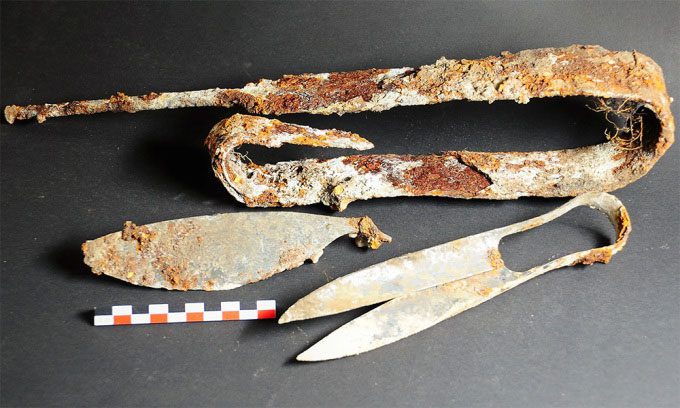An ancient pair of scissors found in a Celtic grave has been preserved so well that they are still shiny and functional for cutting.

Artifacts found in the Celtic grave in Sendling, featuring the remarkably sharp scissors. (Photo: Maximillian Bauer/BLfD)
A team handling explosives was examining a construction site in Sendling, a suburb of Munich, to search for unexploded bombs from World War II when they unexpectedly discovered a buried wooden structure, IFL Science reported on May 3. This was, in fact, a cremation grave dating back to the 2nd or 3rd century BC of the Celts.
The explosive disposal team subsequently invited a group of archaeologists from the Bavarian State Office for the Preservation of Monuments (BLfD) to investigate. They uncovered a range of ancient artifacts, including a bent sword, remnants of a shield and spear, a razor, and a pin. Among these, a 2,300-year-old pair of scissors stood out, preserved in such a way that they appeared almost new, slightly shiny, and still functional. Dr. Mathias Pfeil from the BLfD noted that the primary reason the scissors remain shiny today is the high craftsmanship of ancient artisans.
While the exact reason for the scissors being buried with the Celts remains unclear, scientists suggest that they may have held both practical and symbolic significance for the deceased.
Scissors were an important tool for the Celts, used for cutting hair, wool, and other materials. Therefore, they could have been buried in the grave as a symbol of the deceased’s craftsmanship or trade. However, in ancient mythology, especially in Celtic tales, scissors are often associated with goddesses linked to spinning and weaving—activities vital in Celtic culture. Thus, the scissors may also have been buried for practical use in the afterlife.
The BLfD concluded that from the 3rd to the 2nd century BC, the Celts practiced cremation and buried ashes in pits. Subsequently, valuable grave goods were interred alongside them so that the deceased could use them in the afterlife. The newly discovered grave also helps scientists determine that the individual buried in this cemetery held a high social status.


















































